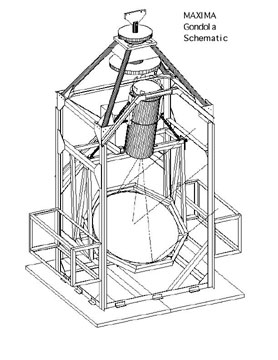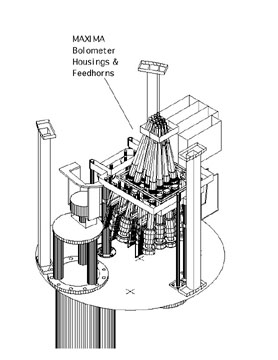|
MAXIMA Results
RESCEU Conference Talk 17 November 1999
Introduction
The MAX/MAXIMA/BOOMERANG Collaborations
Scientific Goals
MAX (Millimeter Anisotropy eXperiment)
MAXIMA (MAX Imaging Array)
MAXIMA/BOOMERANG Collaborator List
BOOMERANG LDB
Photographs and story of MAXIMA 1 flight
The official MAXIPOL website
Introduction
MAXIPOL is a bolometric balloon-borne experiment designed to measure the E-mode polarization anisotropy of the cosmic microwave background radiation (CMB) on angular scales of 10' to 2°.
MAXIPOL is the first CMB experiment to collect data with a polarimeter that utilizes a rotating half-wave plate and fixed wire-grid polarizer. A paper (http://arxiv.org/abs/astro-ph/0308259) describes the instrument design, elaborates on the polarimeter strategy and show data products including preliminary T, Q, and U maps. Our primary data set was collected during a 26 hour turnaround flight that was launched from the National Scientific Ballooning Facility in Ft. Sumner, New Mexico in May 2003. During this flight five regions of the sky were mapped. Data analysis is in final stages.
The MAX/MAXIMA/BOOMERANG Collaborations
MAX was, and MAXIMA and BOOMERANG are, part of the NSF Center for Particle Astrophysics.
Scientific Goals
The purpose of MAX, MAXIMA and BOOMERANG is to measure and eventually to map cosmic microwave background (CMB) anisotropies on the sub-degree angular scale level. This is a significantly smaller angular scale than COBE (>7 degrees) observations. This angular scale is expected to contain Doppler peaks in the average level of fluctuations. Primordial density fluctuations contribute to this, but on the smaller angular scale, some primordial density fluctuations may have collapsed (carrying the CMB photons with them). This creates additional sources of anisotropy caused both by the condensing (compression) of photons with the matter and by the motion. The peak in fluctuations is expected to be near to one degree on the sky, if the Universe has a flat geometry and on smaller angular scales if the Universe is open.
MAXIMA and BOOMERANG will also be able to check the statistical properties of the fluctuations to determine if they are Gaussian (as expected for inflationary big bang models) or more non-Gaussian as expected from topological defect theory.
MAX (Millimeter Anisotropy eXperiment)
MAX is a balloon-borne, bolometric instrument that had 6 flights. A new primary mirror was purchased for the upgrade to MAXIMA. For the first 5 flights MAX utilized a 1.2-meter diameter off-axis parabola and a chopping secondary.
The MAX receiver was a four bolometer photometer operating at frequencies of 3.5, 6, 9 and 14 cm^-1 (number of waves per centimeter or wavelengths of 2.9, 1.7, 1.1, and 0.7 mm respectively). The receiver was improved and altered during the flights to lower temperatures first via a He3 refrigerator operating at 0.3K and then with an ADR (adiabatic demagnetization refrigerator) operating below 0.1K.
List of MAX publications
List of MAX data
MAXIMA (MAX Imaging Array)
MAXIMA is the upgrade of the MAX concept to an array for making images of sections of the sky with an angular resolution of about one fifth of a degree (~12'). MAXIMA utilizes a 1.5-m diameter light-weight chopping primary. MAXIMA is projected to have 14 pixels. For its first flight these will be single frequency-band bolometers but it can handle 4-frequency-channel bolometer assemblies the MAX type.
 MAXIMA Gondola MAXIMA Gondola
Figure 4. Drawing of MAXIMA gondola with the single-pixel MAX receiver used in the September 1996 flight. The "inner frame" holds the primary mirror, secondary optics, and the cryostat. This inner frame tilts with respect to the outer frame to point the beam in elevation. The bottom of the gondola has a pallet constructed with aluminum honeycomb, which is very light and strong. The structural members are made of 3 inch wide aluminum angle. A simplified version of the flywheel system used to point the gondola in azimuth can be seen at the top of the gondola. The entire gondola will weigh about 2,500 lbs.
 MAXIMA Gondola MAXIMA Gondola
schematic in configuration for August 1997 flight. This shows the larger cryostat for the array receiver.

Schematic of the MAXIMA receiver showing the cold optics:
secondary mirror,
tertiary mirror,
Lyot stop,
feed horns,
filters,
bolometer detectors.
It also shows the three cryogenic stages of the five temperature ranges:
Ambient temperature exterior - well below freezing during flight
Liquid nitrogen (77 K) shield
Liquid Helium-4 (4 K at STP, ~2 K at high altitude) shield
Liquid Helium-3 (0.3 K)
Adiabatic Demagnetization Refrigerator (<0.1 K)
The prime focus shown is from the primary mirror. The primary mirror is very light weight - about 12 kilograms and can be kept stationary, oscillate, or make a roughly triangular configuration with time angular scan on the sky. In the following flight the mirror made a 4-degree peak-to-peak scan. The entire optics are enclosed in a large shield.
Cold secondary and tertiary mirrors allow a cold baffle to be placed at at the optimum spot in the optical path. This baffle rejects millimeter-wave radiation from outside the desired beam pattern. An Adiabatic Demagnetization (ADR) will cool the photometers to 100 mK, and a pumped Helium-three stage will provide an intermediate temperature of 300 mK.
Cryostat & Receiver in another potential configuration. Drawing of MAXIMA cryostat and receiver of a version that contains an array of 8 photometers (seen toward left of drawing). Each photometer will have four separate frequency channels and will look at a 20-arcmin wide circular pixel on the sky. Ray tracings are visible in this drawing show the optical path from the entrance of the cryostat to the entrances of the photometer light pipes.

Schematic
Showing the bolometer detector assembly, feed horns, and cold plate of the cryostat.
 Schematic detail of the detector assembly and feed horns. Schematic detail of the detector assembly and feed horns.
 Figure showing the expected beam pattern on the sky for: Figure showing the expected beam pattern on the sky for:
(a) BOOMERANG northern hemisphere flight in spring 1997. The goal is to use the bolometers in total power mode taking advantage of the specially developed electronics. However, each bolometer has a matching partner, at either 2.8, 3.5, or 4 degrees separation so that differences between the members of the pair (electronically and digitally) will provide back up information on smaller angular scales. The scan strategy is to point the bolometers at roughly 45-degrees elevation and then rotate the gondola in azimuth at roughly 1 rpm, which will trace out a circle on the sky. The rotation of the Earth then sweeps that circle on the sky providing coverage of about 25% of the northern hemisphere on one night's flight.
(b) MAXIMA summer 1997 flight configuration The MAXIMA beams are closely packed and are scanned rapidly by the wiggling primary and slowly with azimuth scans of the gondola. The plan for the first flight is to guide using Polaris and scan at high angular resolution a small region in a low dust region near the north pole.
(c) BOOMERANG circumpolar flight in December 1998 The BOOMERANG long duration balloon flight is designed to have higher angular resolution than the northern flight, but similar separation in case atmospheric noise and stability are insufficient for the total power mode.
List of MAXIMA/BOOMERANG collaborators institutions/positions and responsibilities.
Photographs of flight preparations and launch of MAXIMA-0 in September 1995.
 Expected sensitivity for measuring CMB anisotropy power spectrum for the three planned flights. Expected sensitivity for measuring CMB anisotropy power spectrum for the three planned flights.
BOOMERANG
BOOMERANG is the upgrade of the MAX concept to an array for making images of sections of the sky from Long Duration Balloon (LDB) flights.
Back to top
Smoot Group Homepage
|


 MAXIMA Gondola
MAXIMA Gondola


 Figure showing the expected beam pattern on the sky for:
Figure showing the expected beam pattern on the sky for: Expected sensitivity for measuring CMB anisotropy power spectrum for the three planned flights.
Expected sensitivity for measuring CMB anisotropy power spectrum for the three planned flights.